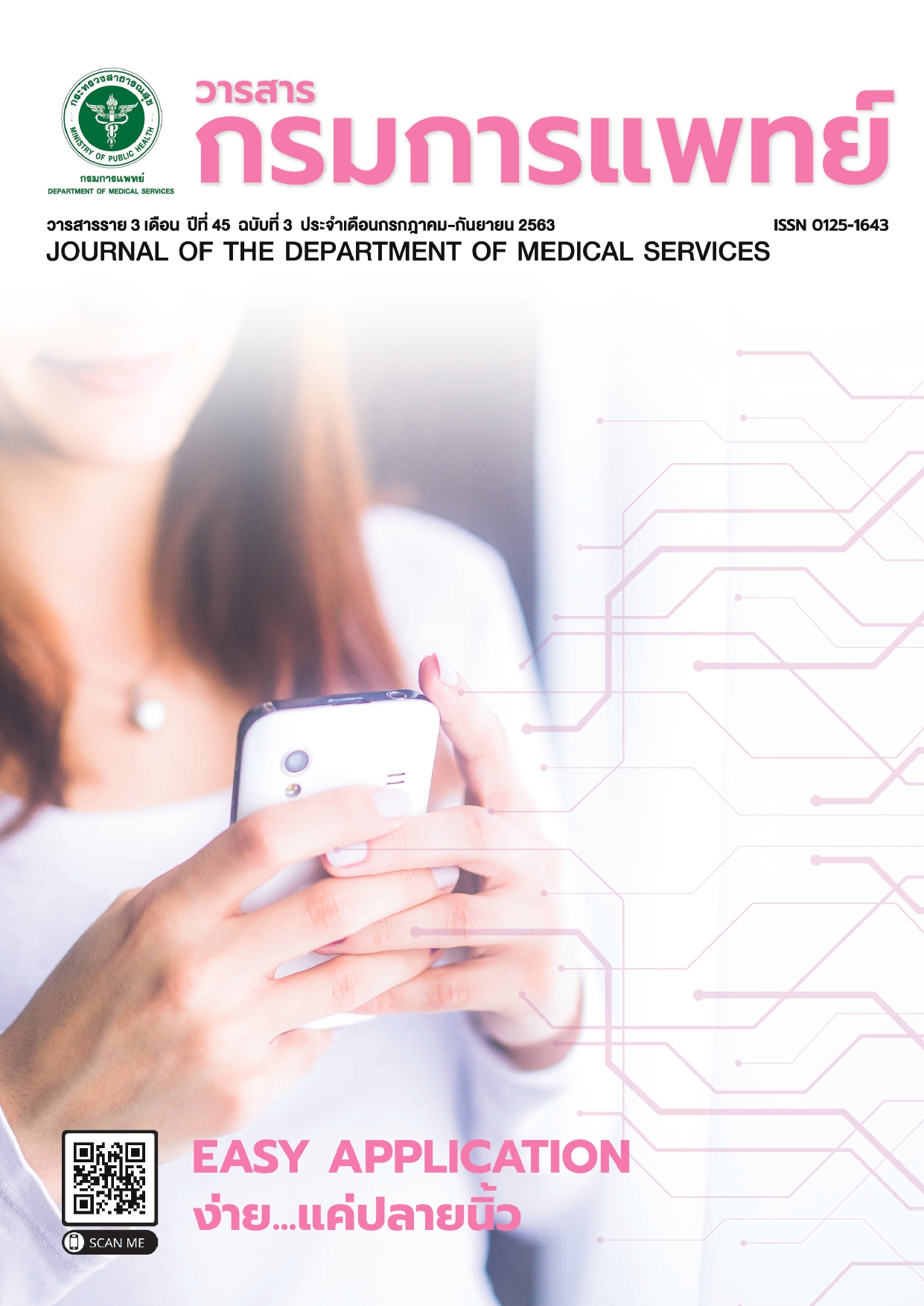Guidelines for the Prevention and Treatment of Withdrawal Syndrome from Opioid Analgesics and Benzodiazepine in Pediatric Intensive Care Patients
Abstract
ผู้ป่วยเด็กในหอผู้ป่วยเวชบำบัดวิกฤตมักมีความปวดทั้งจาก ตัวโรคและหัตถการต่างๆ การให้ยาระงับปวด (analgesic drug) และยาทำให้สงบ (sedative drug) ที่เหมาะสมกับผู้ป่วยจึงมีความสำคัญ เนื่องจากสามารถลดความปวดและทำให้ผู้ป่วยร่วมมือในการ รักษามากขึ้น โดยข้อบ่งชี้ในการใช้ยาระงับปวดและยาทำให้สงบใน ผู้ป่วยเด็กวิกฤต ได้แก่ ใช้ระงับอาการปวดที่เกิดจากโรคหรือหัตถการ ที่ทำให้เกิดความปวด ช่วยให้ผู้ป่วยสามารถหายใจเข้ากับเครื่องช่วย หายใจ ลดการให้ออกซิเจนและช่วยการขับก๊าชคาร์บอนไดออกไซด์ และช่วยให้ผู้ป่วยสูญเสียความจำ (amnesia) ในช่วงที่ได้รับยา ในหอผู้ป่วยเวชบำบัดวิกฤตพบกลุ่มอาการขาดยาได้บ่อยเมื่อให้ยา แก้ปวดกลุ่ม opioid และ ยาทาให้สงบกลุ่ม benzodiazepine (BZD) หยดต่อเนื่องทางหลอดเลือดดำเป็นเวลานาน โดยพบว่า มีความสัมพันธ์กับระยะเวลาที่ให้ยาและขนาดยาสะสม (total cumulative dose) มีการศึกษาพบว่าเกิดขึ้นได้ถึงร้อยละ 50 เมื่อ ให้ยา fentanyl เป็นระยะเวลา 5 วันหรือขนาดยาสะสม 1.6 มิลลิกรัมต่อกิโลกรัมและเกิดขึ้นได้ร้อยละ 100 เมื่อให้ยามากกว่า 9 วันหรือขนาดยาสะสม 2.5 มิลลิกรัมต่อกิโลกรัม2 สำหรับในหอผู้ป่วย เด็กวิกฤต ผู้ป่วยมากกว่าร้อยละ 80 จะได้รับยาแก้ปวดกลุ่ม opioid และยาทำให้สงบกลุ่ม benzodiazepine (BZD) เป็นระยะเวลา มากกว่า 5-10 วันและขนาดยาสะสมมากกว่า 5 มิลลิกรัมต่อกิโลกรัม โอกาสการเกิดภาวะถอนยาจึงมีโอกาสเกิดขึ้นได้เกือบร้อยละ 100 โดยอาการที่พบบ่อยได้แก่ กระสับกระส่าย นอนไม่หลับ มือสั่น ขนลุก หาวบ่อยๆ รับอาหารหรือนมไม่ได้ คลื่นไส้ อาเจียน ท้องเสีย แนวทางการป้องกันและรักษาภาวะถอนยาแก้ปวดกลุ่ม opioid และยานอนหลับกลุ่ม benzodiazepine ในผู้ป่วยเด็กวิกฤต เหงื่อออก อย่างไรก็ตามแม้ภาวะถอนยาแม้ไม่ได้มีอันตรายถึงชีวิต แต่ควรให้การรักษาเพื่อลดความทรมานของผู้ป่วย
References
Siriwansan B. Respiratory care. In: Prakarnrat A, Sanunsilp W, Suksompong S, Toomthong P. Anesthesiology Textbook. 4th edition. Bangkok: A-Plus Print; 2013: P. 215-32.
Chantra M, Lertboonlian R, Yam A. Analgesic, sedation, and neuromuscular blockade in: Anan KositSethi A, Phutthiphan A, Limrangsikul A, Kongkatitham C, Pandi U, Lertboonleng R. Pediatric Critical Care Medicine 4th edition, 1st edition.Bangkok: D-One Book Publishing Company Limited; 2013: P. 229-54.
Taketomo CK, Hodding JH, Kruas DM. Pediatric dosage handbook. 24th ed. 2017-2018.
American Society of Anesthesiologists Task Force on Sedation and Analgesia by Non-Anesthesiologist. Practice Guideline for Sedation and Analgesia by Non- Anesthesiologists.Anesthesiology 2002; 96: 1004-17.
Birchley G. Opioid and benzodiazepine withdrawal syndromes in the pediatric intensive care unit: a review of recent literature. Nurs Crit Care 2009; 14: 26-37.
Anand KJ, Willson DF, Berger J, Harrison R, Meert KL, Zimmerman J, et al. Tolerance and withdrawal fro prolonged opioid use in critically ill children. Pediatrics. 2010; 125: e1208-25.
DE Redmond Jr, Krystal JH. Multiple mechanisms of withdrawal from opioid drugs. Annu Rev Neurosci 1984;7: 443-78.
Ista E, van Dijk M, Gamel C, Tibboel D, de Hoog M. Withdrawal symptoms in critically ill children after long-term administration of sedatives and/or analgesics: a first evaluation. Crit Care Med 2008; 36:2427-32.
Franck LS, Naughton I, Winter I. Opioid and benzodiazepine withdrawal symptoms in paediatric intensive care patients. Intensive Crit Care Nurs 2004; 20:344-51.
Jansson LM, Velez M, Harrow C. The opioid exposed newborn: assessment and pharmacologic management. J Opioid Manag 2009; 5: 47–55.
Ducharme C, Carnevale FA, Clermont MS, Shea S. A prospective study of adverse reactions to the weaning of opioids and benzodiazepines among critically ill children. Intensive Crit Care Nurs 2005; 21:179-86.
Meyer MM, Berens RJ. Efficacy of an enteral 10-day methadone wean to prevent opioid withdrawal in fentanyltolerant pediatric intensive care unit patients. Pediatr Crit Care Med 2001; 2:329-33.
Giby K, Vaillancourt R, Varughese N, Vadeboncoeur C, Pouliot A. Use of methadone for opioid weaning in children: prescribing practices and trends. Can J Hosp Pharm 2014; 67: 149–56.
Jeffries SA, McGloin R, Pitfield AF, Carr RR. Use of methadone for prevention of opioid withdrawal in critically ill children. Can J Hosp Pharm 2012; 65: 12–8.
Wong E, Walker KA. A review of common methods to convert morphine to methadone. J Community Hosp Intern Med Perspect 2013; 7: 2.
Lugo RA, MacLaren R, Cash J, Pribble CG, Vernon DD. Enteral methadone to expedite fentanyl discontinuation and prevent opioid abstinence syndrome in the PICU. Pharmacotherapy 2001; 21: 1566-73.
Siddappa R, Fletcher JE, Heard AM, Kielma D, Cimino M, Heard CM. Methadone dosage for prevention of opioid withdrawal in children. Paediatr Anaesth 2003; 13: 805-10.
Robertson RC, Darsey E, Fortenberry JD, Pettignano R, Hartley G. Evaluation of an opiate-weaning protocol using methadone in pediatric intensive care unit patients. Pediatr Crit Care Med 2000; 1:119-23.
Curley MA, Harris SK, Fraser KA, Johnson RA, Arnold JH. State Behavioral Scale: a sedation assessment instrument for infants and young children supported on mechanical ventilation. Pediatr Crit Care Med 2006; 7: 107–14.
Downloads
Published
How to Cite
Issue
Section
License
บทความที่ได้รับการตีพิมพ์เป็นลิขสิทธิ์ของกรมการแพทย์ กระทรวงสาธารณสุข
ข้อความและข้อคิดเห็นต่างๆ เป็นของผู้เขียนบทความ ไม่ใช่ความเห็นของกองบรรณาธิการหรือของวารสารกรมการแพทย์



